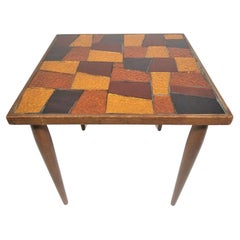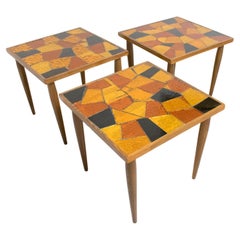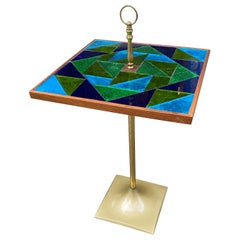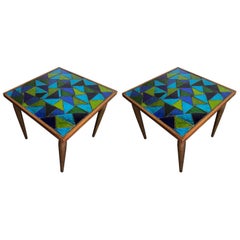Georges Briard Glass Tables
Mid-20th Century Macedonian Side Tables
Glass, Walnut
Mid-20th Century American Mid-Century Modern Side Tables
Foil
Vintage 1960s American Mid-Century Modern Table Lamps
Brass
Recent Sales
Mid-20th Century American Mid-Century Modern Serving Tables
Metal
Mid-20th Century American Mid-Century Modern Side Tables
Glass, Walnut
Mid-20th Century American Mid-Century Modern Table Lamps
Rosewood, Teak
Mid-20th Century American Mid-Century Modern Table Lamps
Stained Glass, Walnut
Mid-20th Century American Mid-Century Modern Table Lamps
Brass
Vintage 1960s American Mid-Century Modern Nesting Tables and Stacking Ta...
Stained Glass, Walnut
Mid-20th Century American Mid-Century Modern Side Tables
Wood, Art Glass
People Also Browsed
21st Century and Contemporary Italian Mid-Century Modern Chandeliers and...
Metal, Brass
Mid-20th Century German Mid-Century Modern Flush Mount
Metal, Brass
Vintage 1970s Italian Hollywood Regency Gueridon
Metal
Vintage 1970s Swedish Mid-Century Modern Flush Mount
Metal
Vintage 1950s Italian Mid-Century Modern Night Stands
Marble
Vintage 1970s Italian Modern Floor Lamps
Brass
Vintage 1950s German Mid-Century Modern Coffee and Cocktail Tables
Brass
Mid-20th Century Italian Hollywood Regency Coat Racks and Stands
Brass
21st Century and Contemporary English Folk Art Side Tables
Iron
Vintage 1960s Italian Mid-Century Modern Chandeliers and Pendants
Metal, Steel
Vintage 1980s Canadian Post-Modern Lounge Chairs
Velvet
2010s American Organic Modern Table Lamps
Plaster, Paper
Vintage 1970s Swedish Wall Lights and Sconces
Velvet
Vintage 1950s Italian Mid-Century Modern Dry Bars
Wood, Cherry, Walnut
Vintage 1950s Italian Credenzas
Wood
2010s Italian Modern Wall Lights and Sconces
Murano Glass
Georges Briard Glass Tables For Sale on 1stDibs
How Much are Georges Briard Glass Tables?
Georges Briard for sale on 1stDibs
Artist and designer Georges Briard (1917–2005) — a name that has for more than a century been a marker of spectacular and stylish vintage glassware, serveware and other household objects — was born Jascha Brojdo in Russian Ukraine.
Brojdo grew up in Poland and moved to the United States in the 1930s, studying art at the University of Chicago and the Art Institute of Chicago before serving in the U.S. Army during World War II. After the war, he began hand-painting metal serving trays while working for Max Wille of M. Wille Company, where Wille suggested changing his name to distinguish his commercial work from his fine art.
As Georges Briard, Brojdo created award-winning designs for items including glasses, trays, coffeepots and dishes in materials like glass, ceramics, metal and wood; he even created gold-plated serveware. His serveware was especially popular from the 1950s to ’70s. It was produced by companies including Culver, Pfaltzgraff and Mdina Glass and sold at high-end department stores like Neiman Marcus and Bonwit Teller. His designs have a signature opulence, evoking the mid-century modern aesthetic of his time as well as borrowing elements from Art Nouveau and Venetian styles, while the quirky, playful barware pieces he produced featured peacock feathers, skulls and tennis balls.
With colorful, intricate patterns and motifs such as butterflies, Christmas trees and Piet Mondrian-esque geometric abstractions, Georges Briard glasses and dishes were found in the homes of the most fashionable hosts of the mid-century. Today, they are highly prized by collectors.
Find a collection of Georges Briard vintage bar glasses, serving trays and other goods on 1stDibs.
A Close Look at Mid-century-modern Furniture
Organically shaped, clean-lined and elegantly simple are three terms that well describe vintage mid-century modern furniture. The style, which emerged primarily in the years following World War II, is characterized by pieces that were conceived and made in an energetic, optimistic spirit by creators who believed that good design was an essential part of good living.
ORIGINS OF MID-CENTURY MODERN FURNITURE DESIGN
- Emerged during the mid-20th century
- Informed by European modernism, Bauhaus, International style, Scandinavian modernism and Frank Lloyd Wright’s architecture
- A heyday of innovation in postwar America
- Experimentation with new ideas, new materials and new forms flourished in Scandinavia, Italy, the former Czechoslovakia and elsewhere in Europe
CHARACTERISTICS OF MID-CENTURY MODERN FURNITURE DESIGN
- Simplicity, organic forms, clean lines
- A blend of neutral and bold Pop art colors
- Use of natural and man-made materials — alluring woods such as teak, rosewood and oak; steel, fiberglass and molded plywood
- Light-filled spaces with colorful upholstery
- Glass walls and an emphasis on the outdoors
- Promotion of functionality
MID-CENTURY MODERN FURNITURE DESIGNERS TO KNOW
- Charles and Ray Eames
- Eero Saarinen
- Milo Baughman
- Florence Knoll
- Harry Bertoia
- Isamu Noguchi
- George Nelson
- Danish modernists Hans Wegner and Arne Jacobsen, whose emphasis on natural materials and craftsmanship influenced American designers and vice versa
ICONIC MID-CENTURY MODERN FURNITURE DESIGNS
- Eames lounge chair
- Nelson daybed
- Florence Knoll sofa
- Egg chair
- Womb chair
- Noguchi coffee table
- Barcelona chair
VINTAGE MID-CENTURY MODERN FURNITURE ON 1STDIBS
The mid-century modern era saw leagues of postwar American architects and designers animated by new ideas and new technology. The lean, functionalist International-style architecture of Le Corbusier and Bauhaus eminences Ludwig Mies van der Rohe and Walter Gropius had been promoted in the United States during the 1930s by Philip Johnson and others. New building techniques, such as “post-and-beam” construction, allowed the International-style schemes to be realized on a small scale in open-plan houses with long walls of glass.
Materials developed for wartime use became available for domestic goods and were incorporated into mid-century modern furniture designs. Charles and Ray Eames and Eero Saarinen, who had experimented extensively with molded plywood, eagerly embraced fiberglass for pieces such as the La Chaise and the Womb chair, respectively.
Architect, writer and designer George Nelson created with his team shades for the Bubble lamp using a new translucent polymer skin and, as design director at Herman Miller, recruited the Eameses, Alexander Girard and others for projects at the legendary Michigan furniture manufacturer.
Harry Bertoia and Isamu Noguchi devised chairs and tables built of wire mesh and wire struts. Materials were repurposed too: The Danish-born designer Jens Risom created a line of chairs using surplus parachute straps for webbed seats and backrests.
The Risom lounge chair was among the first pieces of furniture commissioned and produced by celebrated manufacturer Knoll, a chief influencer in the rise of modern design in the United States, thanks to the work of Florence Knoll, the pioneering architect and designer who made the firm a leader in its field. The seating that Knoll created for office spaces — as well as pieces designed by Florence initially for commercial clients — soon became desirable for the home.
As the demand for casual, uncluttered furnishings grew, more mid-century furniture designers caught the spirit.
Classically oriented creators such as Edward Wormley, house designer for Dunbar Inc., offered such pieces as the sinuous Listen to Me chaise; the British expatriate T.H. Robsjohn-Gibbings switched gears, creating items such as the tiered, biomorphic Mesa table. There were Young Turks such as Paul McCobb, who designed holistic groups of sleek, blond wood furniture, and Milo Baughman, who espoused a West Coast aesthetic in minimalist teak dining tables and lushly upholstered chairs and sofas with angular steel frames.
Generations turn over, and mid-century modern remains arguably the most popular style going. As the collection of vintage mid-century modern chairs, dressers, coffee tables and other furniture for the living room, dining room, bedroom and elsewhere on 1stDibs demonstrates, this period saw one of the most delightful and dramatic flowerings of creativity in design history.



